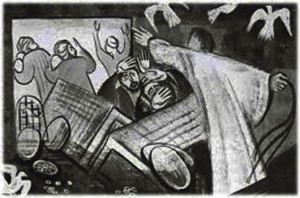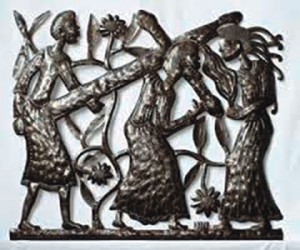Jesus’ Hands
I read it on Stuff. The theory goes like this—ever since we, mankind, have been able to close our hands into a fist, we have been punching each other in the face. Fist fighting does not originate in the cowboy movies. Instead, it occurred four million years earlier when our ancestors started walking on two feet, and the proportions of our hands enabled us to form a fist. This, as the theory goes, explains the evolution of the face to a shortened jaw, strengthened jawbone, spongy cheeks and more strengthening in the bones around the eyes, adaptations made to be able to better absorb the punches. So I was curious. Is Jesus ever described as having his hands closed into a fist in the bible? The following is what I discovered when looking at the four gospels of the New Testament.
Matthew 8:3 Jesus stretched out his hand and touched him. Confronted with a man with a “virulent” skin disease, Jesus heals him through touch. The image of Jesus’ hand with the descriptive verb, to stretch, suggests an open hand, the palm open and visible and Jesus’ arm fully extended so that the palm and inside fingers of his hand can rest on the man needing to be healed.
Mark 6: 6 He cured a few sick people by laying his hands on them. The laying on of hands provides an image of open palms and fingers pressed flat against the person.
In John 8:1-11, the woman caught in adultery is surrounded by men pointing their fingers at her. When you point your index finger, you make a partially closed fist with the index finger extended and the other three fingers curled under and held in place with the thumb. The pointed finger is a warning—punches are possibly about to occur. This is what was happening here. The men were first pointing their fingers at the woman. Next they are planning to punch her by extending their closed fists to her in the form of a hurled rock. With all this hostility what does Jesus do? Jesus bent down and started writing on the ground with his finger. John 8:7.
To write he needs to use his index finger. His hand is formed into a partially closed fist too. And even if the act of writing is non aggressive, and therefore the position of Jesus’ hand is simply as it looks, in an act of writing, Jesus does this in response to the accuser’s challenge. The gesture of Jesus’ hand is perceived as giving a warning to the men in front of him. They are waiting to see if a punch is about to follow. Jesus knows what they are waiting for as well. But instead of punching with his fist, Jesus stands, giving his full height to the challenge, and says, Let the one among you who is guiltless be the first to throw a stone at her John 8:8. Jesus plays their game, but spins it off in an entirely unexpected direction. Jesus now crouches back down to continue his writing and the men now find Jesus’ writing disconcerting. Never a punch is thrown, only threats are made, and the woman is left unharmed.
Jesus is prepared to challenge, face people directly and enter into a dialogue. He does not use his fists, even with the Pharisees. In the sevenfold indictment of the scribes and Pharisees recounted in Matthew 23:13-36 and Luke 11:39-48,52, Jesus calls them blind guides, hypocrites, full of corruption of every kind, are like clean cups on the outside but inside full of “extortion and wickedness”, are like unmarked tombs, serpents, and are murderers of the prophets. The Pharisees were fuming when they heard this. They definitely felt like Jesus had hit them with something. Yes he had hit them, but with words of truth about the state of their souls and how distant their relationship was with God. Yet when the Pharisees get their chance to get back at Jesus, Jesus is as quiet as a lamb. He allows them, through their armed lackeys, to take him away like a criminal. He refuses to resist saying, “Put your sword back, for all who draw the sword will die by the sword.” Matthew 26: 52.
In the New Testament we see Jesus surrounded by the threat of closed fists, (Roman soldiers, stoning, Pharisees plotting murder) and Jesus is holding his hands open and unfurled, expressing compassion, bringing a healing touch, revealing his palms and the inside of his fingers, touching others with kindness. Yet again Jesus surprises us by giving us an example when he does use his fists. He held a whip and drove the sellers, the money changers, the cattle, sheep and doves out of the temple as he told them, “Take all this out of here and stop using my Father’s house as a market.” John 2:16. Jesus closes his hand into a fist for His Father against the sin of dishonouring God.
In the hour of Jesus’ death— nailed to a cross, Jesus’ hands are bloodied, torn, scourged, bruised and pierced by a nail; yet still his hands are open and facing out to us, to the very end of his life. This final gesture is immortalised in the crucifixes we hang in our homes. We see the palm and insides of Jesus’ hands, not furled into a fist but opened out, inviting us, even in his final breaths: “Shoulder my yoke and learn from me, for I am gentle and humble in heart, and you will find rest for your souls. Yes, my yoke is easy and my burden light.” Matthew 11:28-30.
The only time Jesus uses his fists is when he is protecting his Father’s house and I described a perceived partial fist in John’s story of the woman caught in adultery. Rather than using his fists to fight, Jesus uses words when squaring off with his opponents, words that can only come from God when he looks directly into our souls. Mainly, Jesus’ hands are described as open and flat expressing compassion, openness and trust. It’s taking the rest of us a long time to unclench our fists. Our open hands at mass when we give each other a sign of the peace with a handshake is certainly a step in the right direction.




 Entries(RSS)
Entries(RSS)